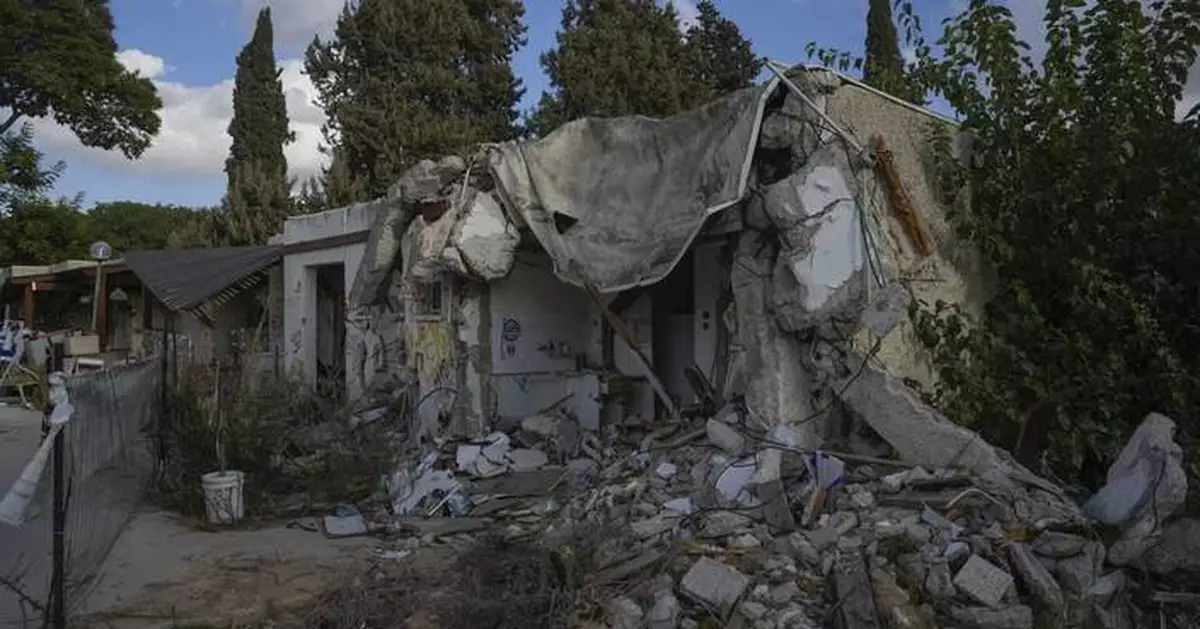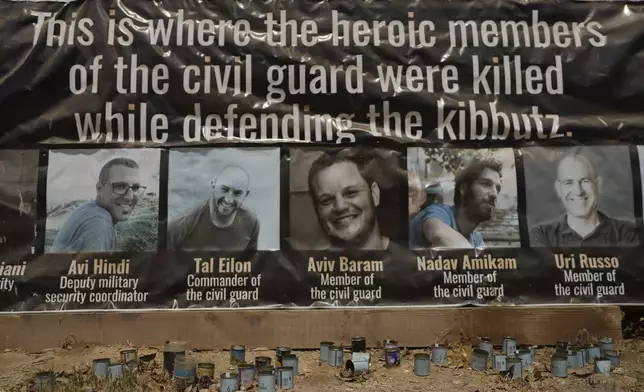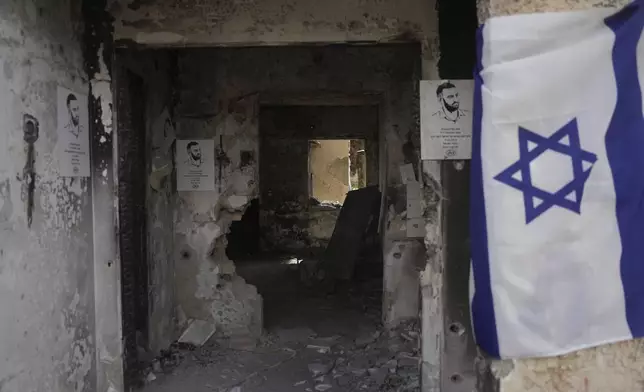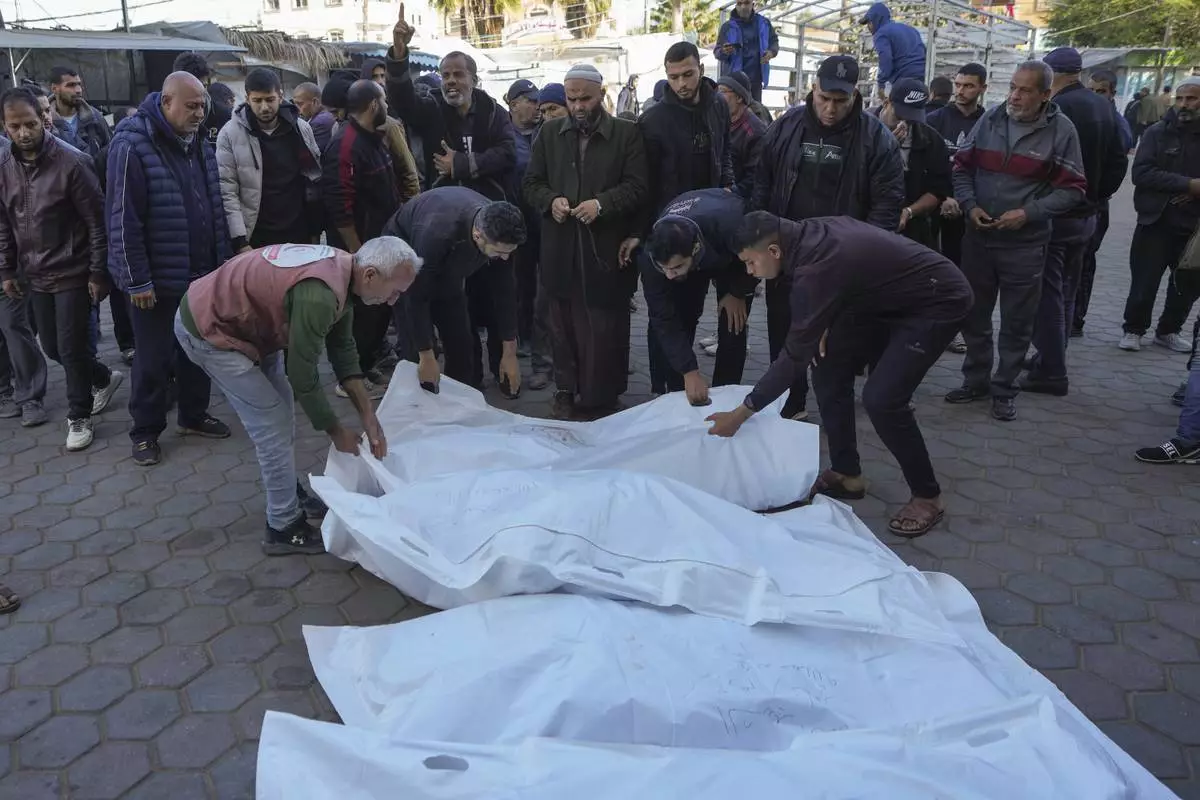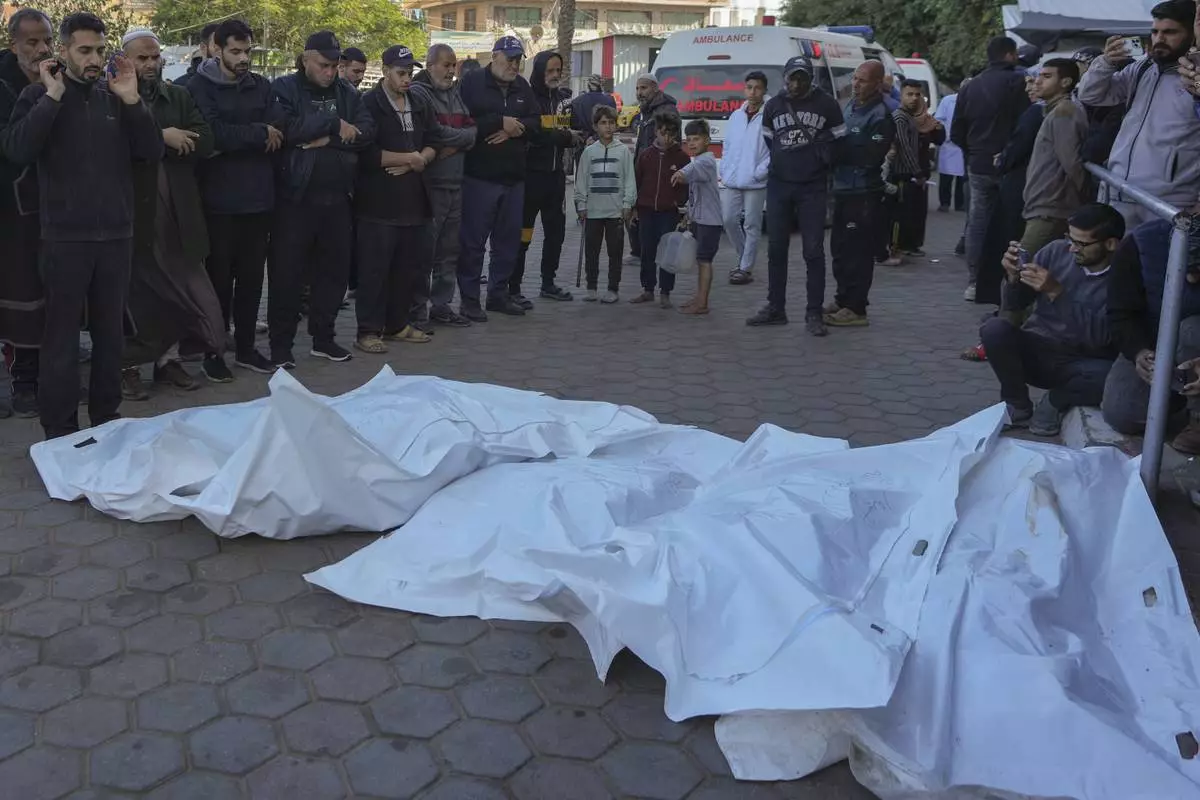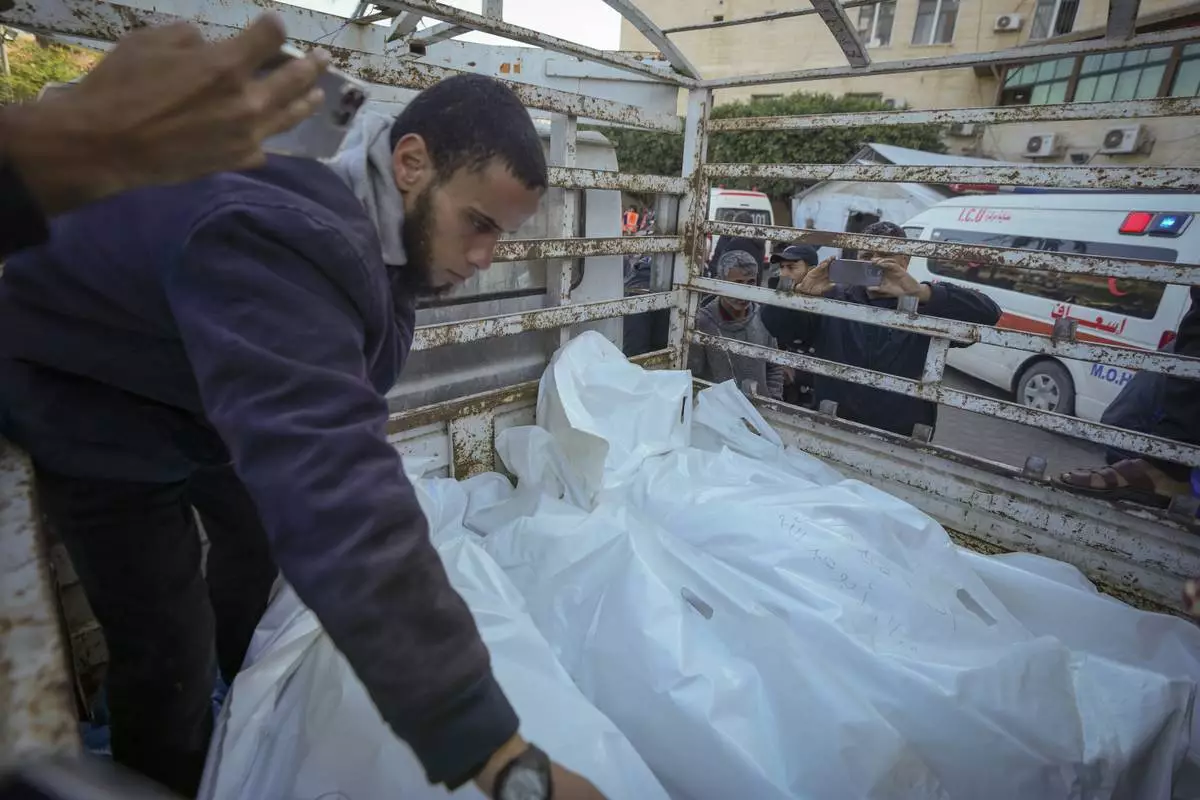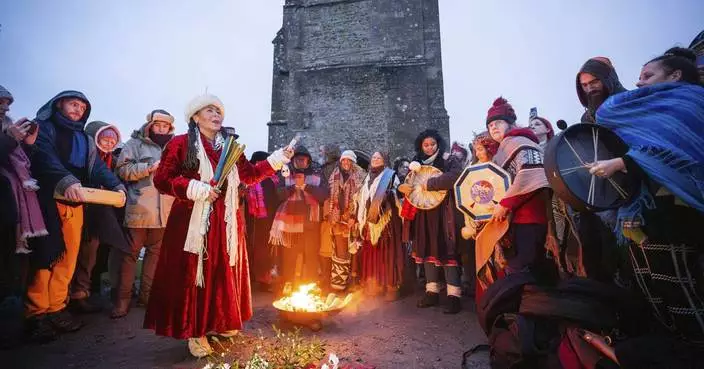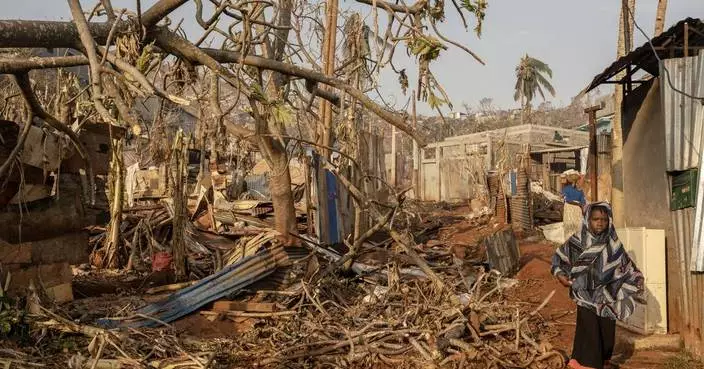KFAR AZA, Israel (AP) — On a sun-dappled day in Kibbutz Kfar Aza, Liora Eilon stood at the spot where her son was killed. She stooped to pick a figurine from the pile of belongings scattered around an abandoned home nearby.
“Every time we come here, Tal leaves us a little message,” the 71-year-old said, turning over the plastic soldier in her hands.
It has been a year since Hamas militants stormed into this community within sight of the border fence surrounding Gaza. Eilon's 46-year-old son, Tal, who was the Kfar Aza civilian defense commander, was killed in the early moments of the attack, as he ran to the kibbutz armory to grab a weapon.
Now living in a university dormitory in Israel’s north, Liora Eilon wonders if she’ll ever return home to this place, seared into Israeli history for that day of mass death, when the militants killed some 1,200 people in southern communities and took about 250 others hostage. The attack sparked an ongoing Israeli campaign in Gaza that has killed more than 41,600 Palestinians and laid waste to much of the territory.
“How can I trust the government who abandoned me here, who betrayed me, promised me that my family was safe here?” she said. “The government wants us to go back to Kfar Aza, but I need more to feel safe.”
Only about 50 of Kfar Aza’s 1,000 residents have returned. They live among the skeletons of houses burned by explosives, riddled with bullet holes or reduced to rubble by tank shells during the battle that raged for days.
The others are scattered in dorms and hotels further north. The Associated Press spoke to a dozen residents who shared feelings of extreme vulnerability to future attack and deep misgivings about Israel’s military and government, and the Palestinians on the other side of the fence.
Some wondered whether such a scarred place could ever be lived in at all.
“Are we going to live inside a memorial? Are we going to see a plaque every few meters, he was killed here and he was killed here?” asked Zohar Shpack, 58, who has returned and serves in the civilian defense squad. “I don’t know yet.”
The seasons have spun by since Oct. 7. Relatively untended, Kfar Aza’s orchards have borne new fruit. With few to harvest, soldiers guarding the community have their pick from loads of fresh avocadoes.
The land still holds traces of the day. On trees hung with fresh pomegranates, some of last year’s fruit remains, charred and black like used grenades. Gardener Rafael Friedman says he still finds teeth and bones in the soil when he rakes back the overgrowth — likely remnants of Hamas militants killed in the fighting.
Kfar Aza has always been a close-knit place. It takes just 15 minutes to walk from one end to the other, past neighborhoods, orchards and a soccer pitch. Many residents grew up here and raised families alongside each other.
Now photos of slain young people, couples killed together and hostages are posted everywhere. During the day, former residents like Eilon guide tours, hold memorials and see familiar faces. When night falls, most disappear to hotel rooms to the north.
Every Friday, survivors gather on Shachar Schnorman’s porch for dinner, filling the kibbutz with the rare sound of laughter.
“It’s the only place where people can talk about the seventh and all the people at the table understand exactly what they are talking about,” Schnorman said.
“We do whatever we can to try to build community, to try to show ... that people can live here,” he said.
The government says it will rebuild. Meanwhile, it's constructing pre-fabricated houses for residents in another kibbutz, Ruhama, about 15 kilometers (10 miles) away. After two years there, they say authorities want them to return to Kfar Aza.
About two-thirds of the community plan to move into the temporary housing. On a recent tour, some enthusiastically examined the box-like structures. It’s a chance, they said, to live together and rebuild on the southern land they’re accustomed to.
But some weren’t convinced Kfar Aza will be rebuilt and not sure they’d ever feel safe returning.
They want to know why it took so many hours before soldiers arrived at the kibbutz. The military has launched an investigation into what happened, but has not yet released its results. An investigation into the military’s failures at neighboring Kibbutz Be’eri found a “lack of command and control, a lack of coordination and a lack of order” among the units that fought there.
Prime Minister Benjamin Netanyahu’s government has brushed off calls for accountability, saying it will investigate at war’s end.
Simona Steinbrecher feels too frozen in time to make a decision now about whether to return. Her daughter, Doron, a veterinary nurse who spent her girlhood in Kfar Aza, was dragged by militants into Gaza on Oct. 7. She is among 66 Israelis still held captive. Hamas is believed to hold the bodies of 35 others.
The 65-year-old Steinbrecher last saw her daughter in a Hamas propaganda video. Doron’s skin was pale, her voice weak.
“Without Doron, it’s still the seventh of October,” her mother said. “And we won’t go home until she’s home.”
Hostage families and many residents of southern communities are boycotting the government’s ceremony commemorating Oct. 7. To them, as long as it fails to bring hostages home and refuses to investigate and take responsibility for its mistakes, it has blood on its hands. Instead, residents of Kfar Aza will hold a small tribute and lower the kibbutz flag to half-mast.
Residents said they have nothing but admiration for the troops who fought that day. But they are furious at the military higher-ups, blaming them for a command structure that collapsed when the kibbutz needed it most.
When she recounts the day, Eilon is gripped with fury and astonishment — over 35 hours of horror her family endured and the military’s response.
When the sirens began blaring that Saturday morning, Eilon thought it would take the army minutes to arrive, she told the AP as she toured the bullet-riddled remnants of her home.
It took hours.
Her family scrambled into their safe room. A son and daughter muscled the door shut against gunmen trying to get inside. Granddaughters, Gali and Mika, hid under the bed. Eilon got a message saying Tal had gone out to fight.
The five huddled in the saferoom, hearing the attackers’ shouts and gunfire, not knowing whether Tal was dead or alive. Israeli troops finally gained control of their house, and Eilon said she saw how scared and confused the young soldiers looked.
Gali shared with them desperate texts from her friends across the kibbutz trying to escape the rampage.
“She became a 15-year-old commander of an IDF elite unit,” said Eilon, using the acronym for the Israeli military.
Still, the troops didn’t evacuate the family. It was only on Sunday afternoon, as militants were hiding out in the house again, that soldiers hustled them out.
As she ran into her backyard, Eilon saw a tank swivel its cannon at her house. It fired, collapsing her home on the militants inside.
Soon after being rescued, Eilon learned Tal was dead.
“I’d known it all along,” she said. “But some part of me was hoping that he was injured, that he was unconscious in some hospital.”
As the battle still raged, some residents were evacuated early and sped away in army jeeps. Hanan Dann, a young father, recounted passing a cluster of soldiers at a gas station just outside the kibbutz, who looked like they were waiting for orders.
“I wanted to say, there’s fighting inside still, there’re people dying,” he said. “They could have saved them.”
Soldiers and militants fought in Kfar Aza for days. By the end, militants had killed 64 civilians and 22 soldiers and dragged 19 hostages into Gaza.
Nearby, in the recesses of the Negev desert, stands a decrepit water tower. It’s a remnant of Be’erot Yitzhak, a kibbutz abandoned after a deadly 1948 Egyptian attack during the war that led to Israel’s creation.
“Will that be what Kfar Aza looks like 10 years from now?” asked Dann. “Just a stop on the highway I can point out to my kids?”
Even those who want to reinhabit it know Kfar Aza will never be the same.
Shpack, the civilian guard member, said he understands why no one would bring a child here now, pointing to the border fence. Every few minutes, an Israeli warplane drops a bomb on Gaza, puncturing the kibbutz's silence with a loud boom.
“And even once the bombs end, how can you raise him here?" Shpack asked. "How do you explain what happened here?”
For some, the kibbutz’s fate is tied to Gaza.
Some want Israel to take a hard line in the future.
Marcus Scharfstein, 29, who lives in the kibbutz, said he won’t feel completely safe until Israel reestablishes Jewish settlements in Gaza. Israel unilaterally withdrew its soldiers and some 8,000 Jewish settlers from Gaza in 2005.
“If I will know that in Gaza right now, there are 10, 20 villages of Jewish people," he said, “I will feel in control again,” adding he did not feel that way before the Oct. 7 attack.
But others say as long as there is no peace agreement with Palestinians, they will again be on the front lines of another Oct. 7. Some of Gaza's Palestinians once lived in these same arid reaches of what is now southern Israel. Almost no trace is left of their villages after Israeli troops drove them out during the 1948 war.
“We’ve tried war enough times and it never led to anything good,” Eilon said. She wants a new government that will talk to the Palestinians to find “some arrangement for us to live together on the same land.”
“I’m dreaming for the day with an open fence from here to the sea, with two people living together.”
Find more coverage at https://apnews.com/hub/mideast-wars
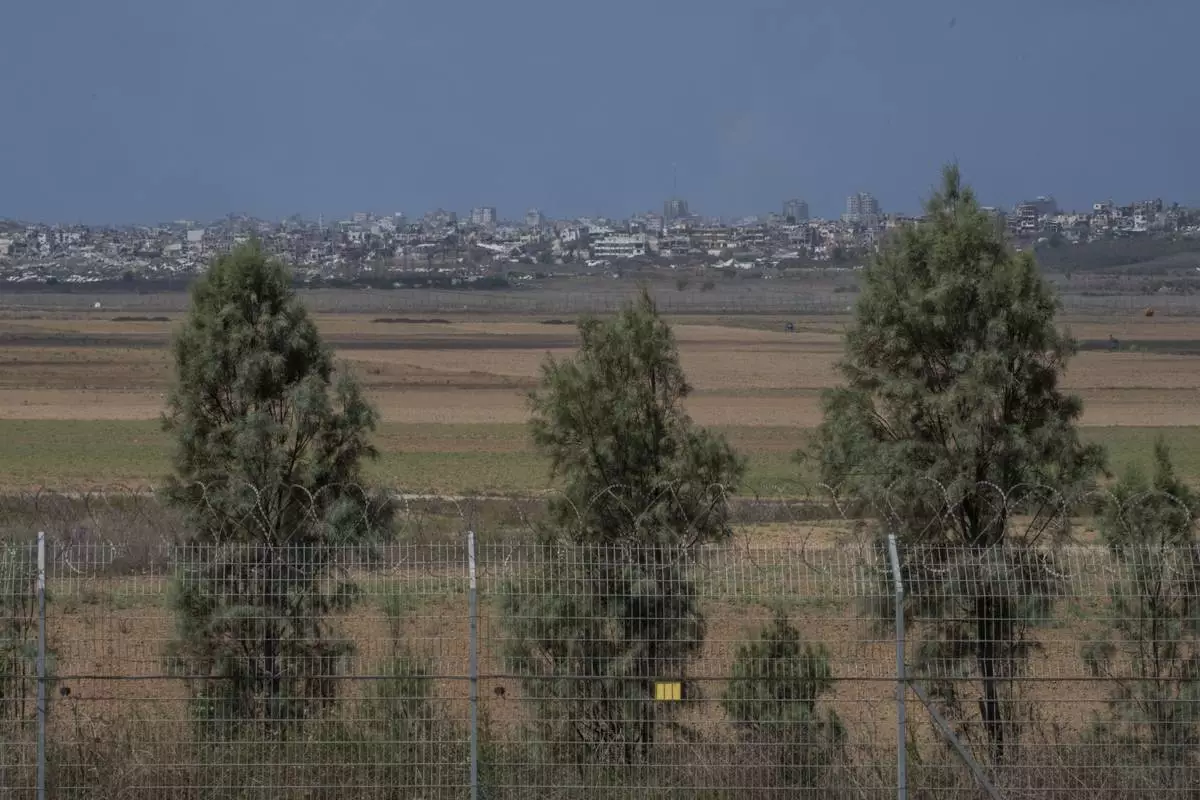
Destroyed buildings in the Gaza Strip are visible from Kibbutz Kfar Aza, southern Israel, Monday, Sept. 16, 2024. (AP Photo/Ohad Zwigenberg)
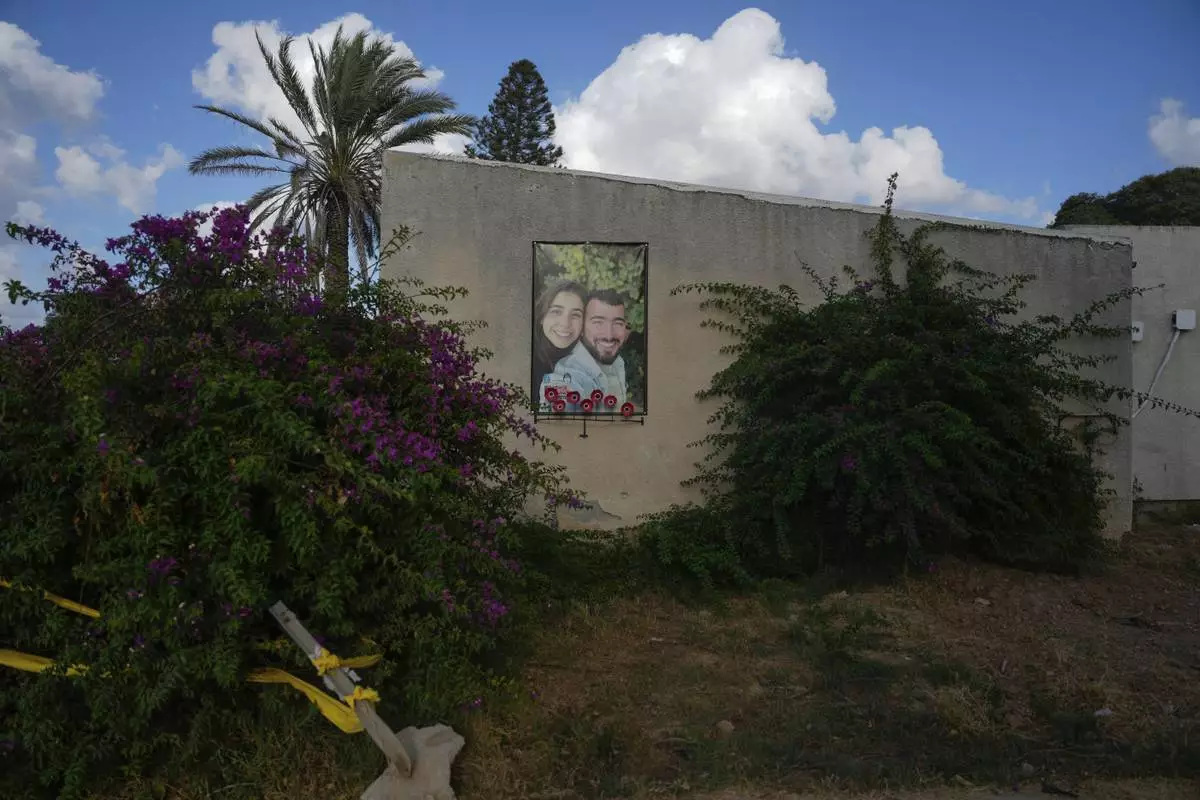
A picture of Niv Raviv, 27 and Nirel Zini, 31, a couple killed by Hamas militants on Oct. 7 in Kibbutz Kfar Aza, hangs on a wall of their old home nearly a year after their killing in the southern border community, Israel, Monday, Sept. 16, 2024. (AP Photo/Ohad Zwigenberg)
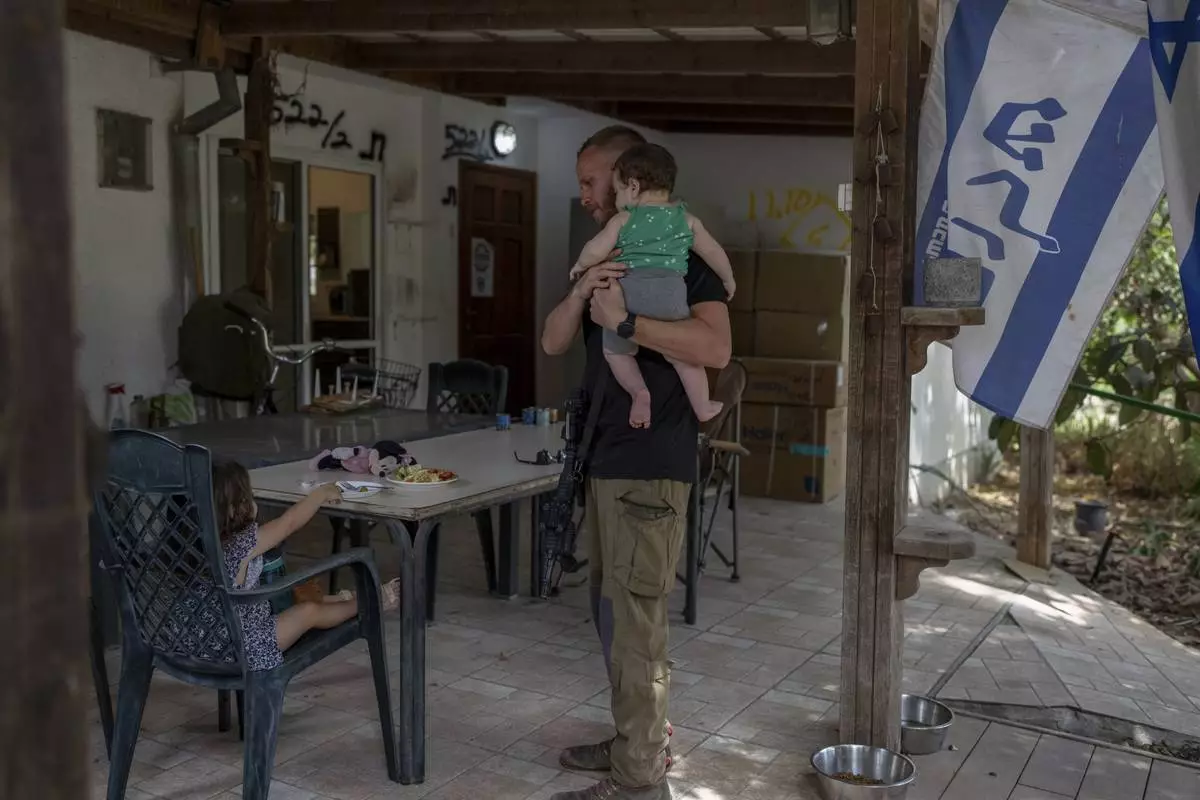
A member of Kibbutz Kfar Aza civilian defense squad with his family at their home in the near-empty kibbutz, Monday, Sept. 16, 2024. (AP Photo/Ohad Zwigenberg)
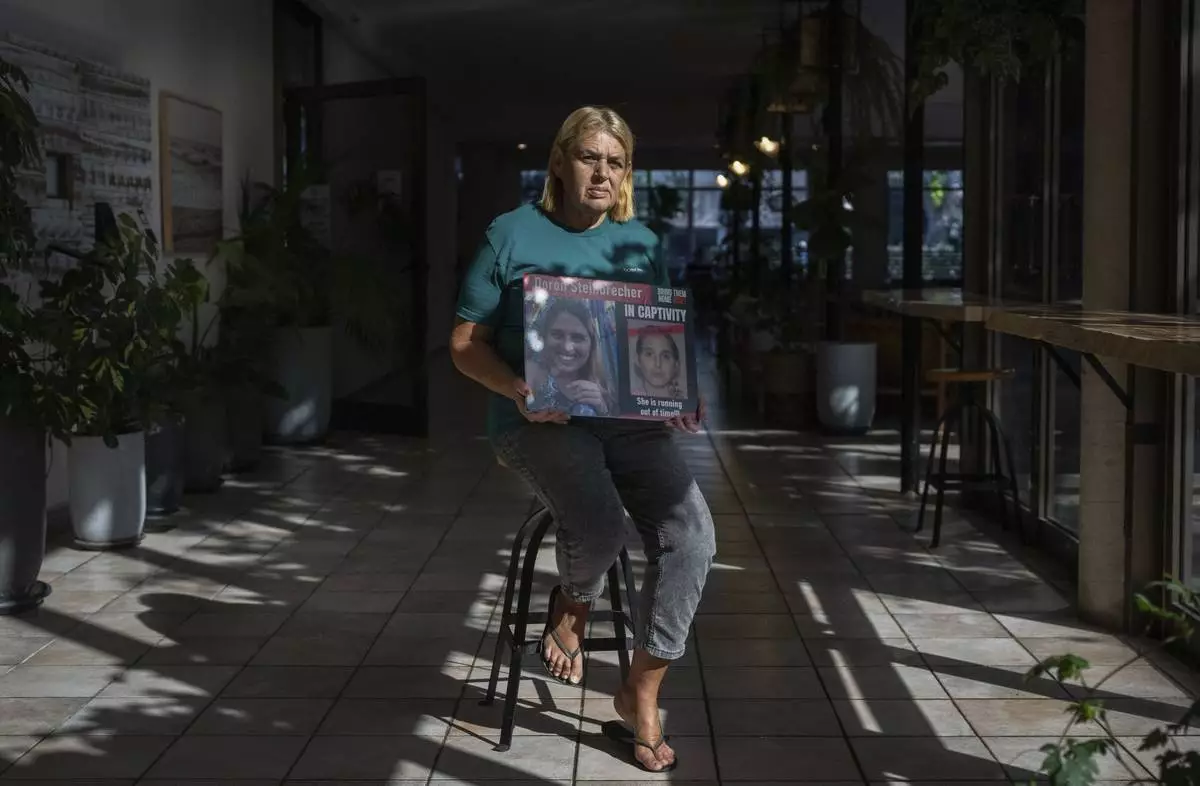
Simona Steinbrecher, whose daughter, Doron Steinbrecher, was kidnapped by Hamas militants on Oct. 7, from Kibbutz Kfar Aza poses for a portrait in Kibbutz Shefayim, Israel, Sunday, Sept. 23, 2024. (AP Photo/Ohad Zwigenberg)
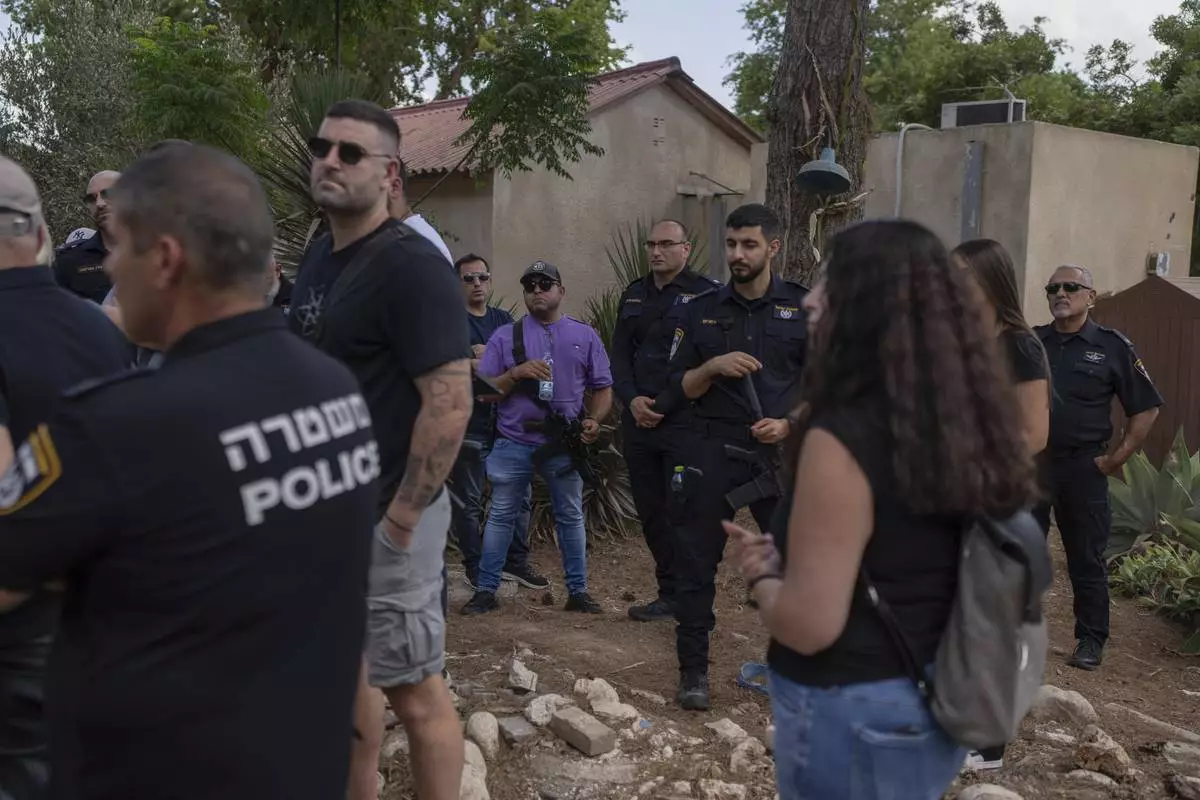
Israeli police officers guard a tour of visitors viewing the damage wrought by the Oct. 7 Hamas onslaught on Kibbutz Kfar Aza, southern Israel, Monday, Sept. 16, 2024. (AP Photo/Ohad Zwigenberg
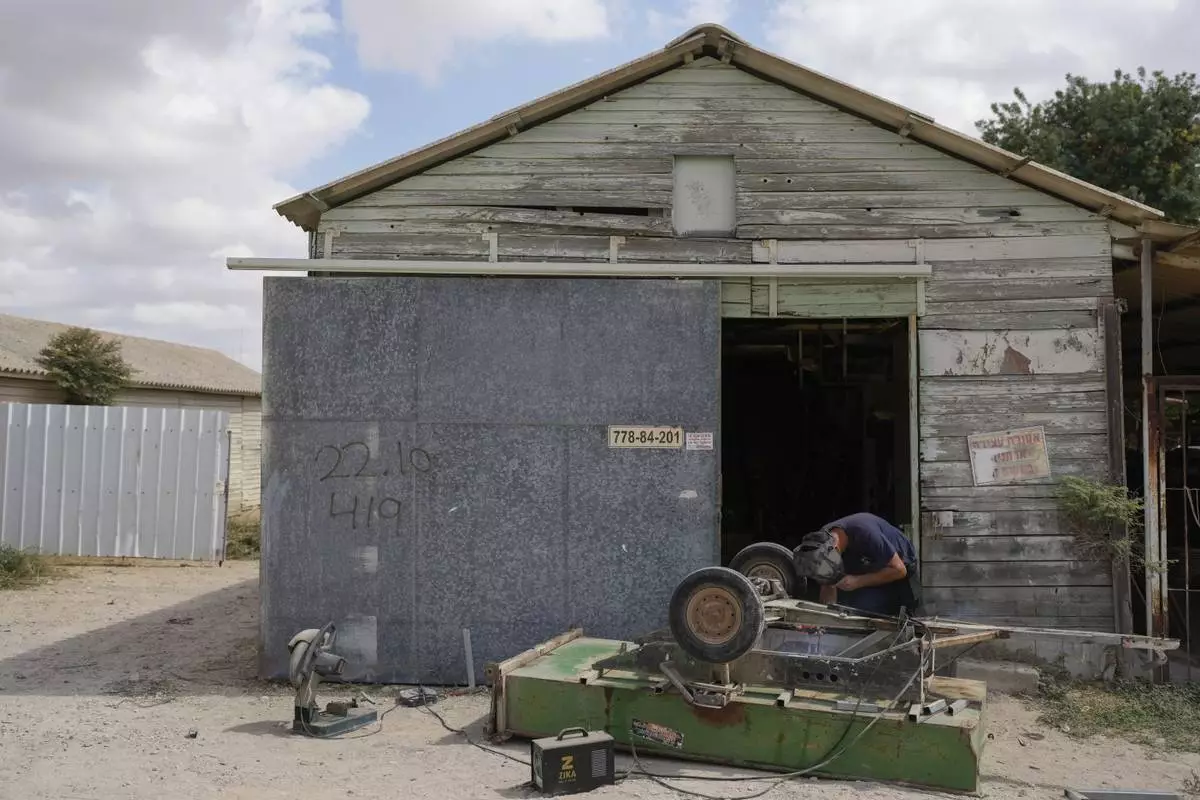
A resident of Kibbutz Kfar Aza, southern Israel, repairs a freight cart nearly a year after a deadly Hamas onslaught on the kibbutz, Monday, Sept. 16, 2024. (AP Photo/Ohad Zwigenberg)
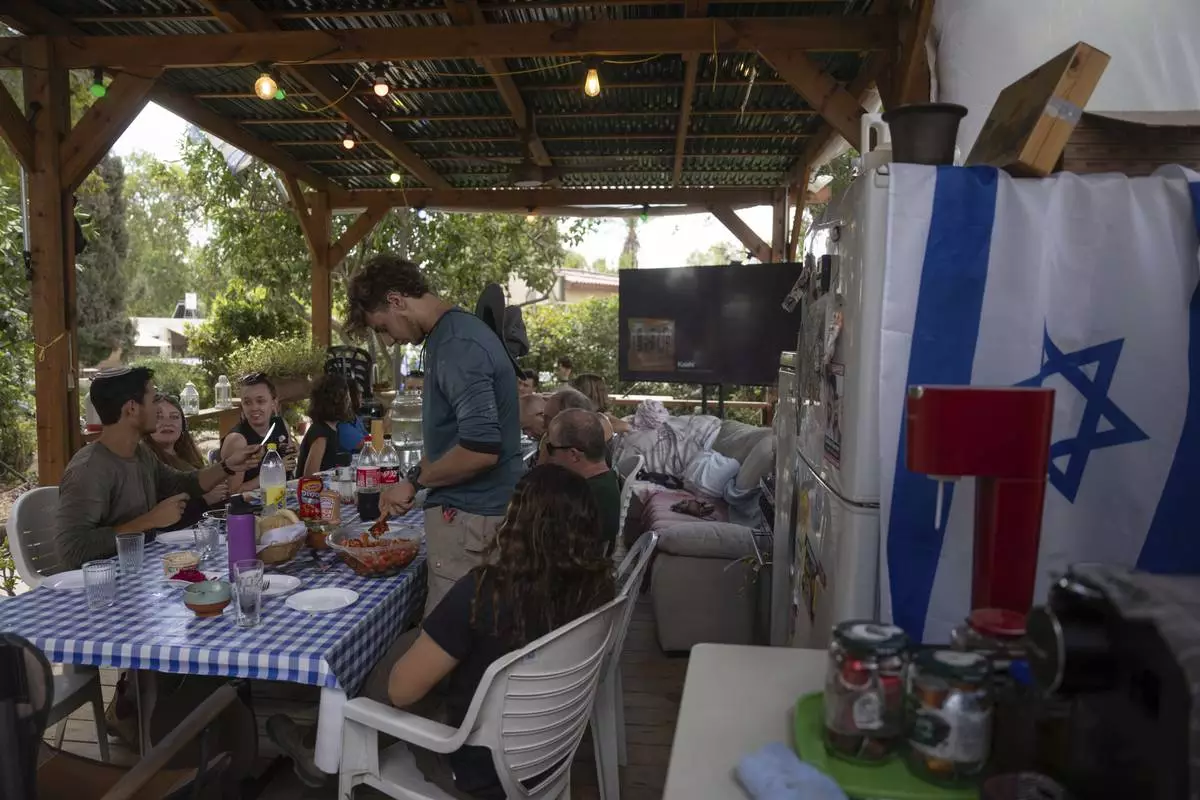
Residents who live in the near-empty kibbutz of Kfar Aza almost a year after the deadly Hamas onslaught eat lunch together in the community in southern Israel, Monday, Sept. 16, 2024. (AP Photo/Ohad Zwigenberg)
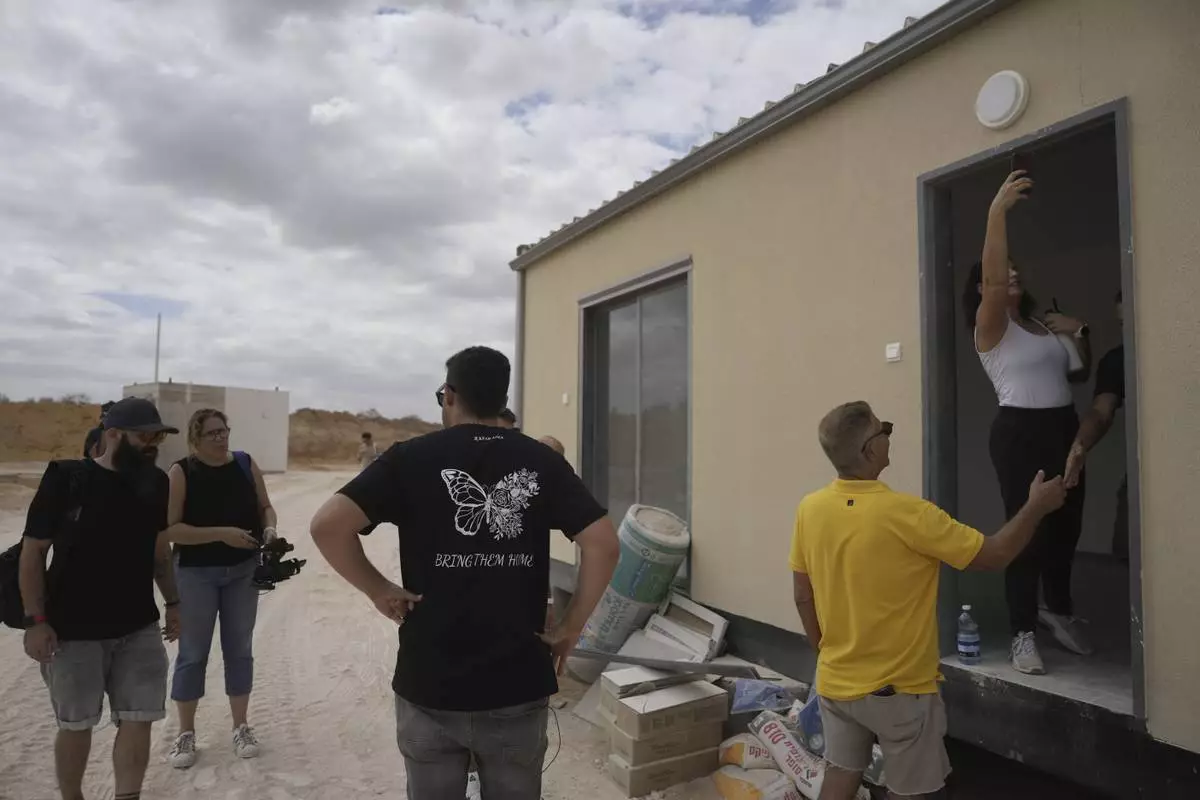
Former residents of Kibbutz Kfar Aza, a community partially destroyed in the Oct. 7 Hamas attack on Israel, visit the construction site where workers build them temporary housing in Kibbutz Ruhama, southern Israel, Tuesday, Sept. 17, 2024. (AP Photo/Ohad Zwigenberg)
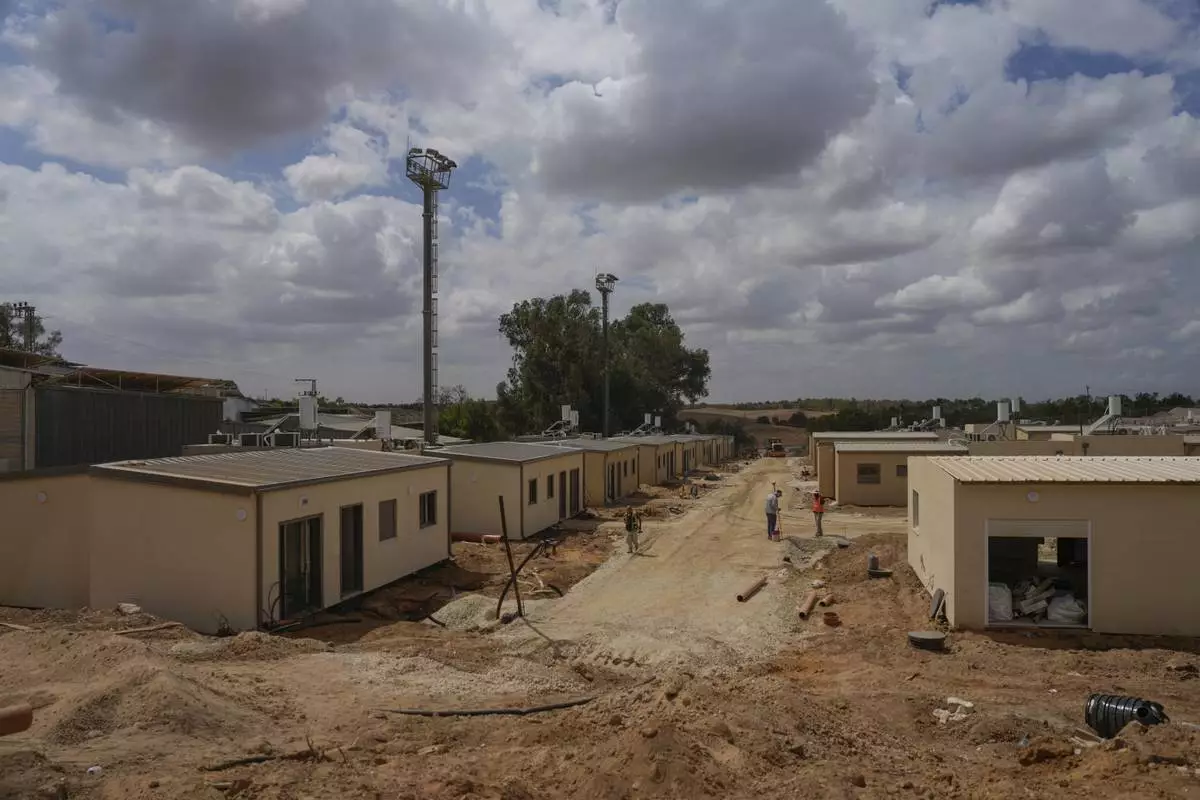
Construction workers build temporary homes where former residents of Kibbutz Kfar Aza, a community partially destroyed in the Oct. 7 Hamas attack on Israel, will live in Kibbutz Ruhama, southern Israel, Tuesday, Sept. 17, 2024. (AP Photo/Ohad Zwigenberg)
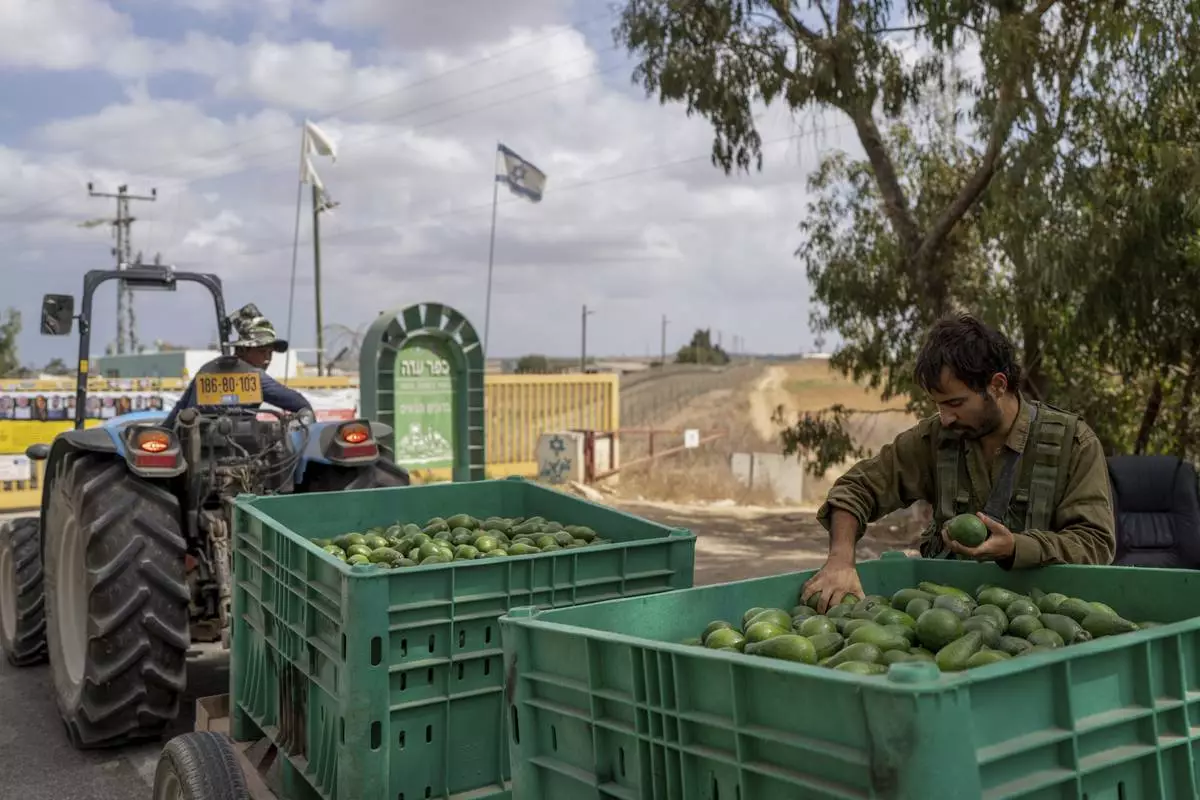
A reservist guarding the entrance gate to Kibbutz Kfar Aza, southern Israel, takes avocados grown inside the kibbutz from a tractor, Monday, Sept. 16, 2024. (AP Photo/Ohad Zwigenberg)
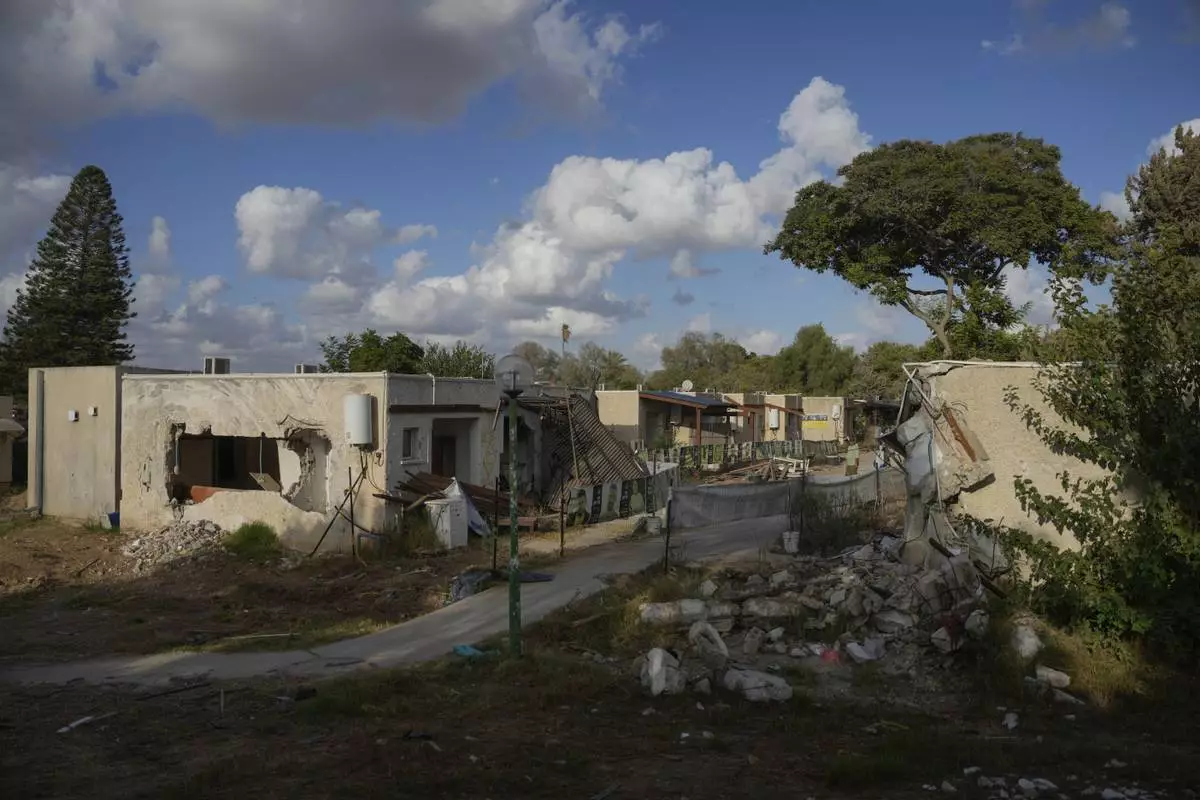
Nearly a year after the deadly Hamas attack Oct. 7, the neighborhood where young people of Kibbutz Kfar Aza used to live remains heavily damaged in the southern Israel border community, Monday, Sept. 16, 2024. (AP Photo/Ohad Zwigenberg)

Memorial plaque commemorating the men from the civilian defense squad of Kfar Aza who were killed by Hamas militants in the Oct. 7 attack on the kibbutz in southern Israel, Sunday, Aug. 18, 2024. (AP Photo/Ohad Zwigenberg)
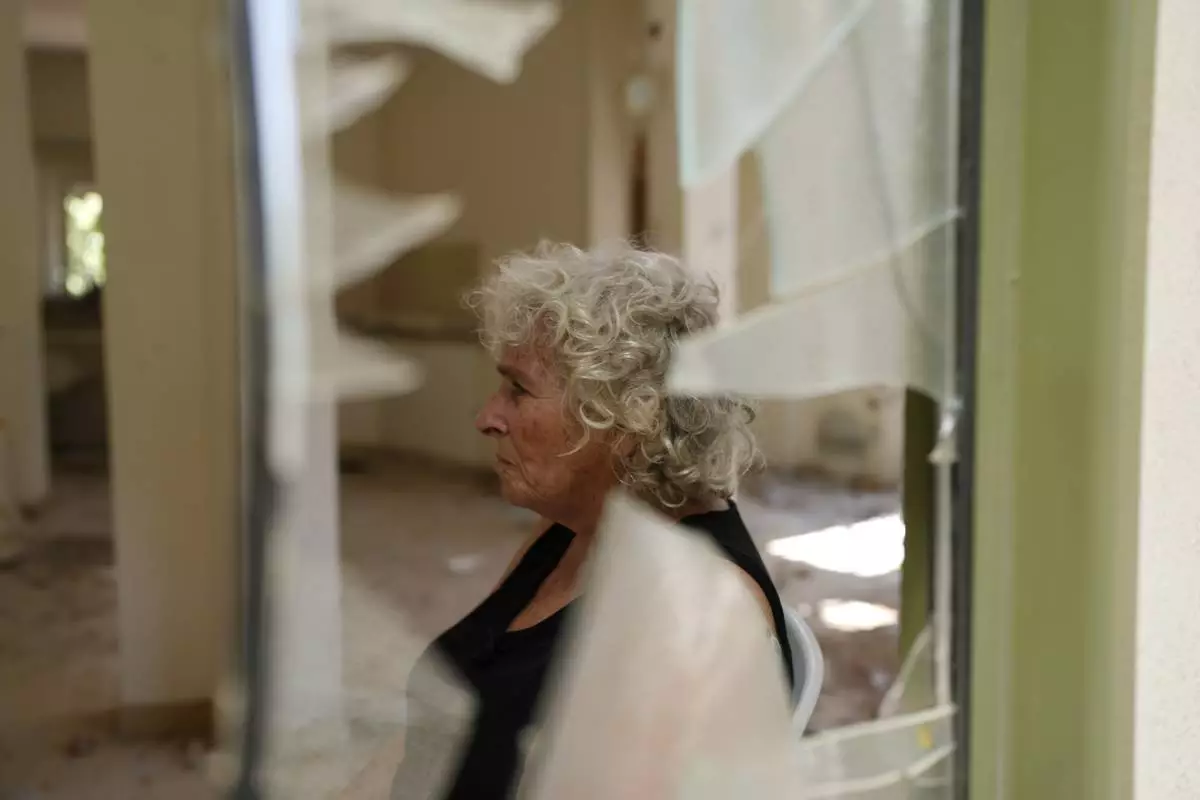
Liora Eilon, whose son, Tal Eilon, was killed by Hamas militants on Oct. 7, poses in her blasted-out home with her daughter Hadas Eilon-Carmi, left, in Kibbutz Kfar Aza, southern Israel, Sunday, Aug. 18, 2024. (AP Photo/Ohad Zwigenberg)
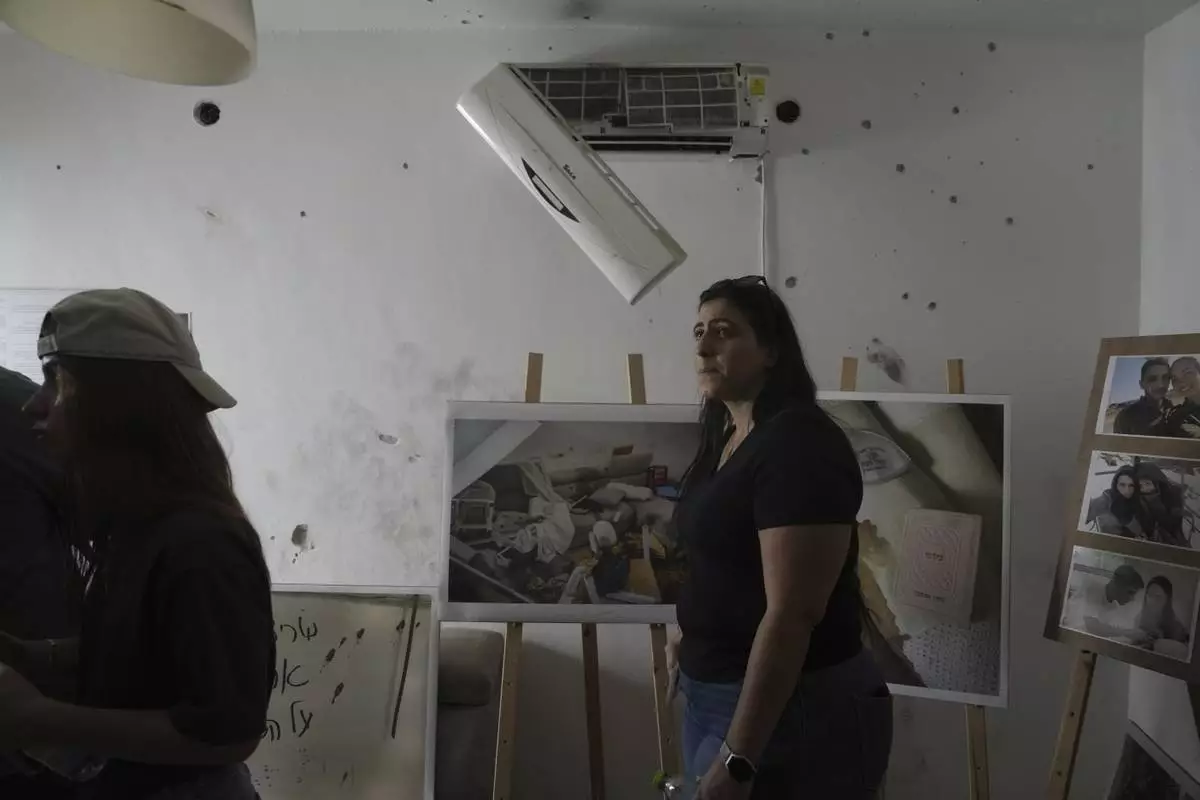
Visitors tour a bullet-ridden house in Kibbutz Kfar Aza a year after Hamas militants attacked the border community in southern Israel, Monday, Sept. 16, 2024. (AP Photo/Ohad Zwigenberg)
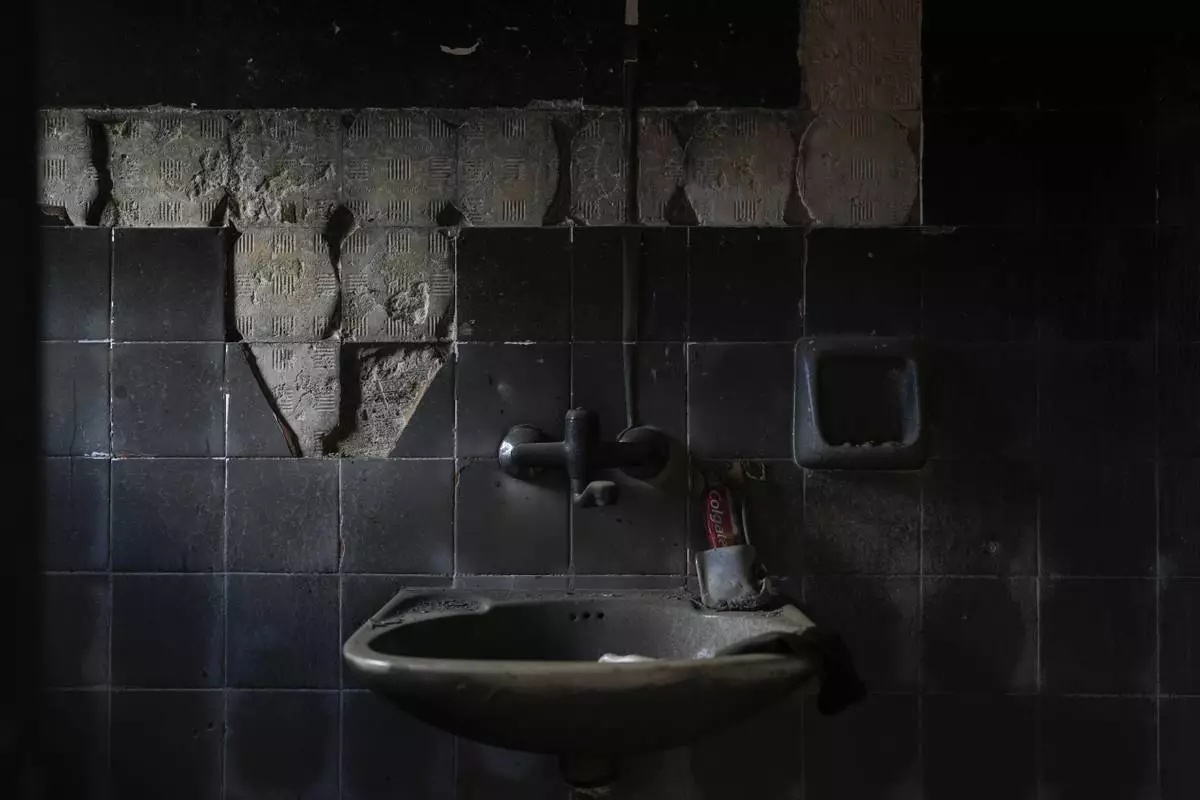
A sink in a house burnt by Hamas militants remains singed and blackened a year after the deadly Oct. 7 attack on Kibbutz Kfar Aza in southern Israel, Monday, Sept. 16, 2024. (AP Photo/Ohad Zwigenberg)
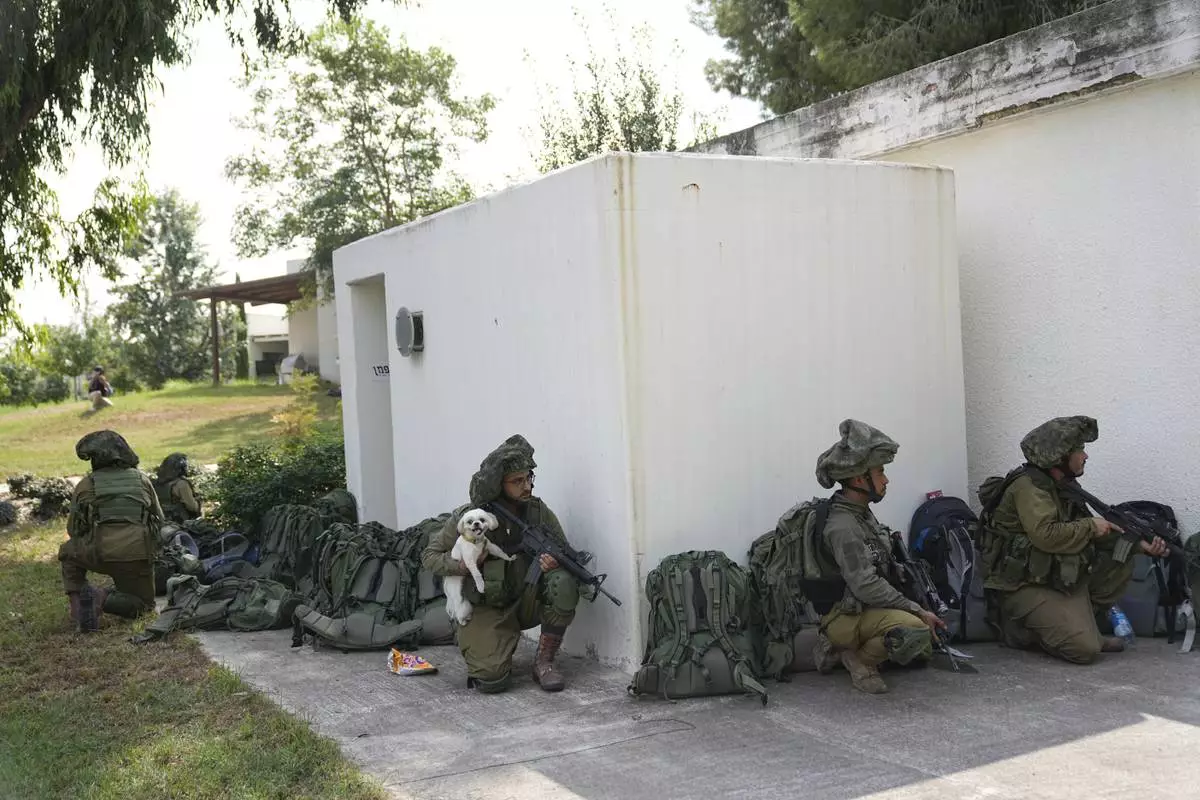
FILE- Israeli soldiers deploy in Kibbutz Kfar Aza on Tuesday, Oct. 10, 2023. (AP Photo/Ohad Zwigenberg, File)
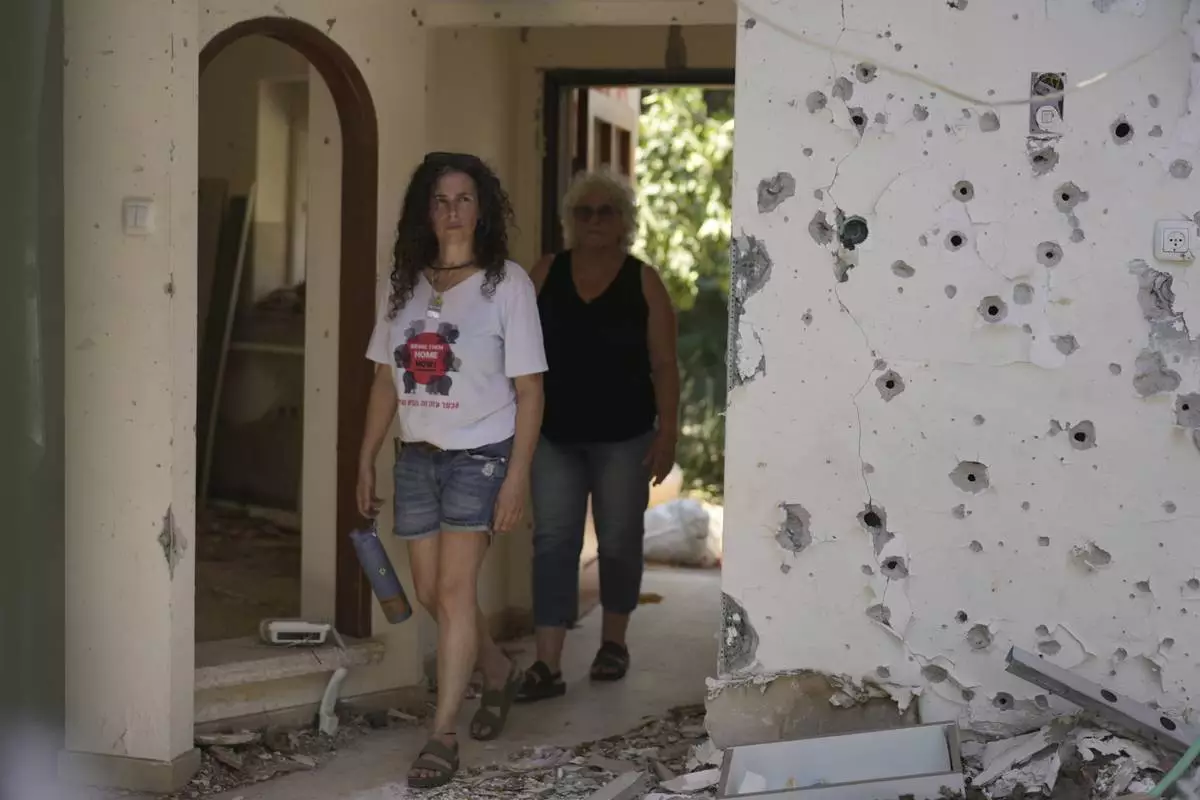
Liora Eilon, right, walks through her home that was destroyed by an Israeli tank on Oct. 7, with her daughter, Hadas Eilon-Carmi, left, in Kibbutz Kfar Aza, southern Israel, Sunday, Aug. 18, 2024. (AP Photo/Ohad Zwigenberg)
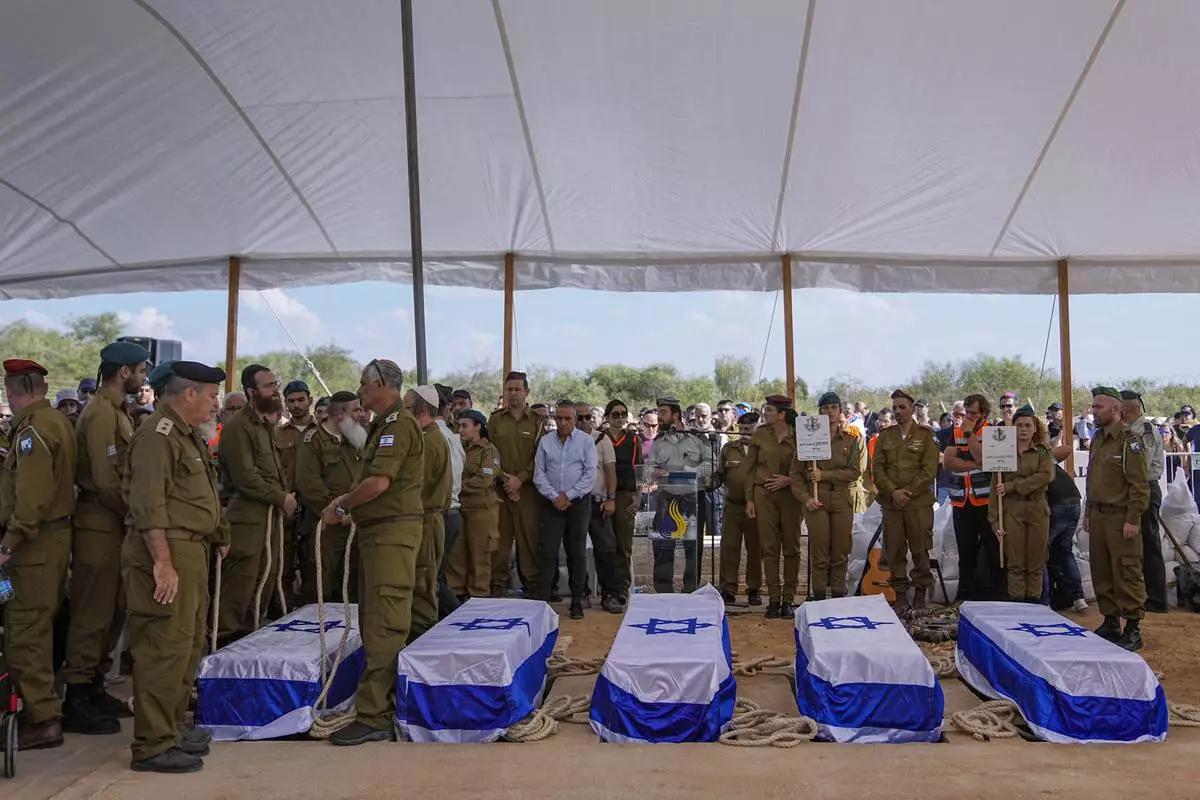
FILE- Mourners gather around the five coffins of the Kotz family during their funeral in Gan Yavne, Israel, Tuesday, Oct. 17, 2023. The family was killed by Hamas militants on Oct. 7 at their house in Kibbutz Kfar Aza near the border with the Gaza Strip,. (AP Photo/Ohad Zwigenberg, File)
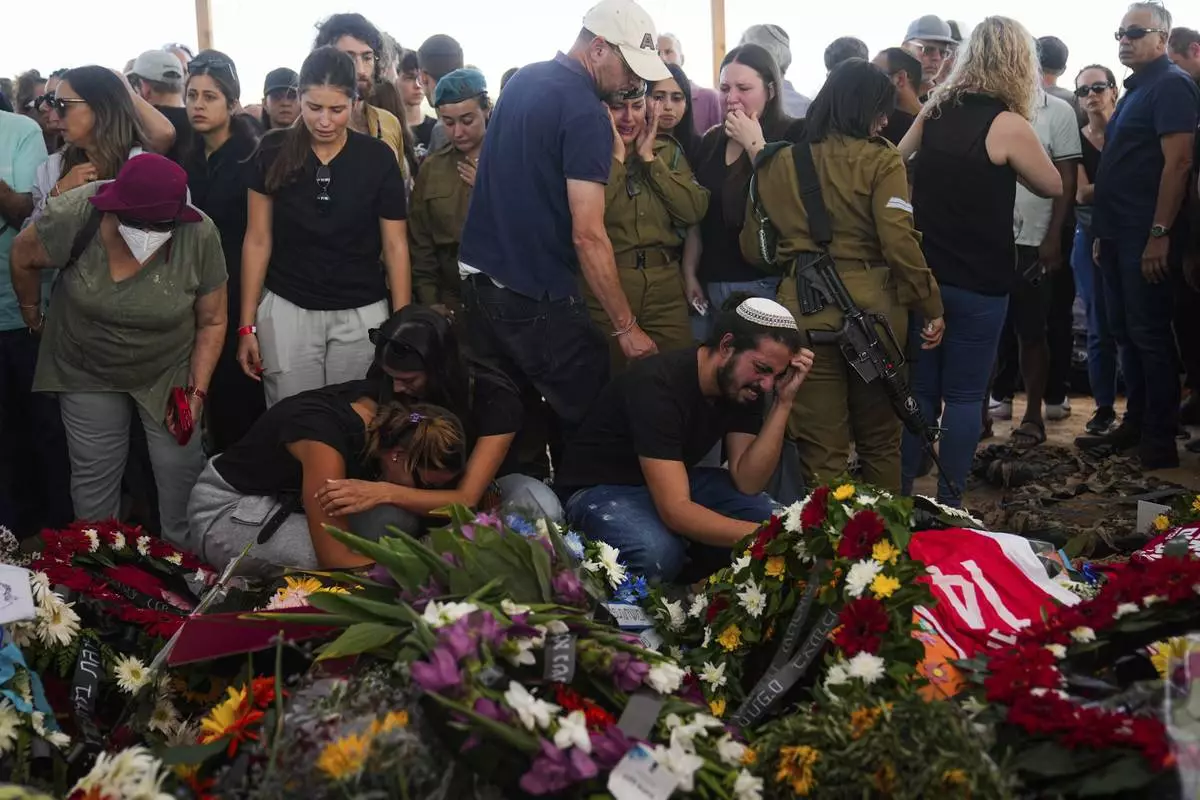
FILE- Mourners attend the funeral of the Kotz family in Gan Yavne, Israel, on Oct. 17, 2023. The Israeli family of five was killed by Hamas militants on Oct. 7 at their house in Kibbutz Kfar Aza near the border with the Gaza Strip. (AP Photo/Ohad Zwigenberg, File)

An Israeli flag is hung on a destroyed house nearly a year after the deadly Hamas attack on Oct. 7, in Kibbutz Kfar Aza, Israel, Monday, Sept. 16, 2024. (AP Photo/Ohad Zwigenberg)
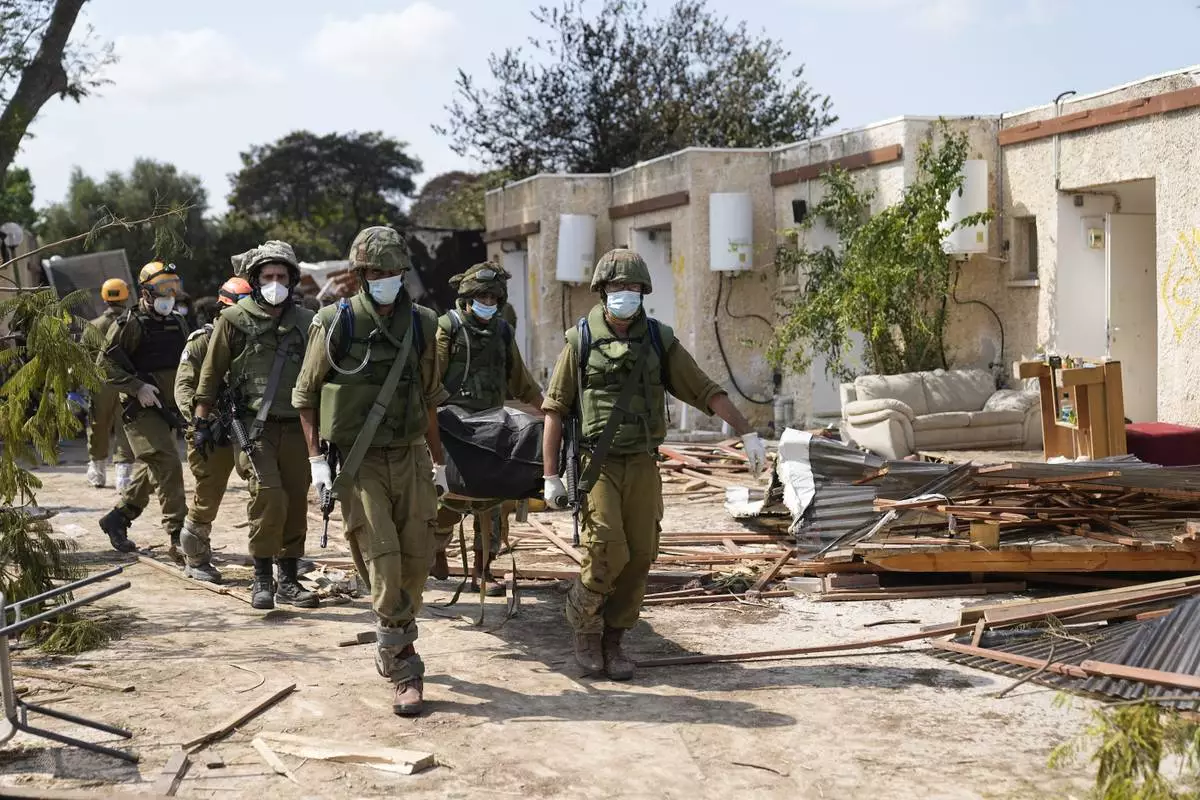
FILE- Israeli soldiers carry bodies of Israelis in Kibbutz Kfar Aza on Oct. 10, 2023. (AP Photo/Ohad Zwigenberg, File)
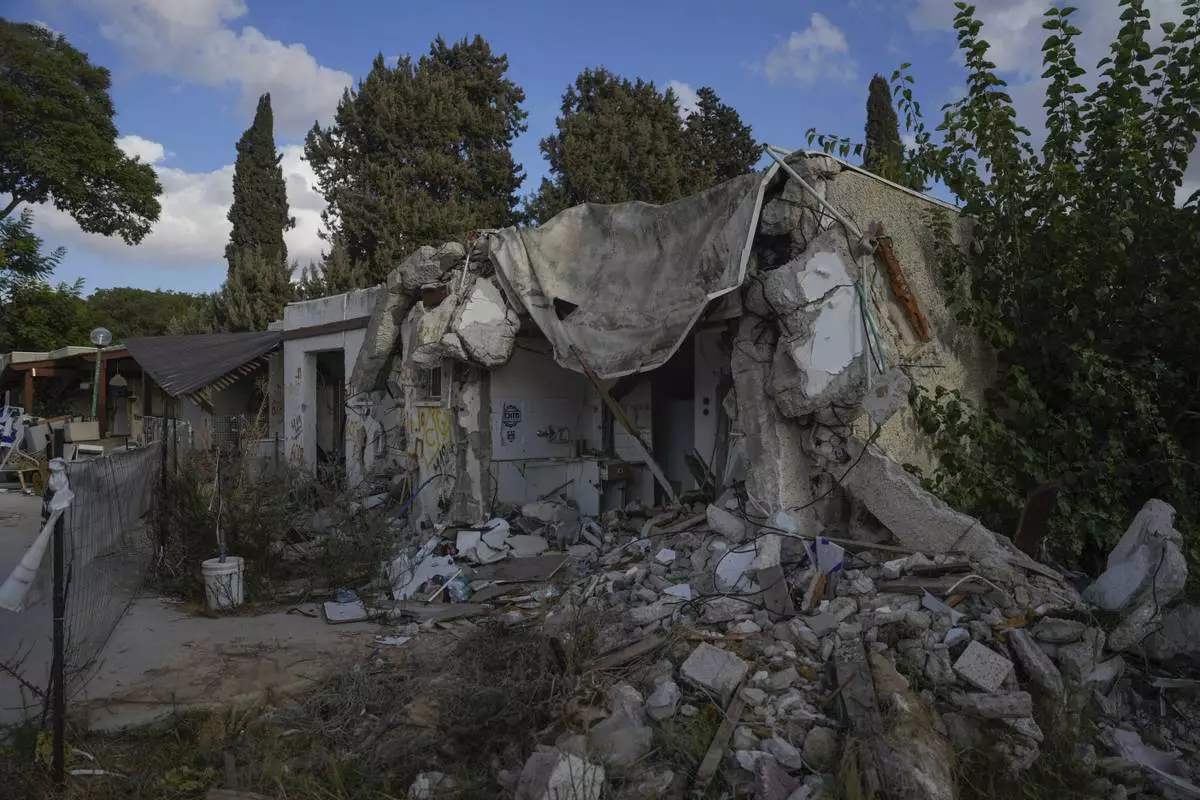
House in the part of Kibbutz Kfar Aza where young people used to live is destroyed in the southern border community, Monday, Sept. 16, 2024. (AP Photo/Ohad Zwigenberg)


